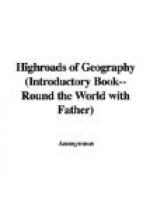[Illustration: {Arab tent}]
10. In front of an Arab tent you are almost sure to see a woman grinding corn between two large stones. There is a hole in the top stone, and into this she pours the grain.
11. She turns the top stone round and round, and the grain is ground into flour, which oozes out at the edges. With this flour she makes cakes.
* * * * *
9. Amongst the Arabs.—II.
1. Date palms grow on every oasis. The date palm is a beautiful tree. It is very tall, and has a crown of leaves at the top.
2. The fruit grows in great golden clusters. Sometimes a cluster of dates weighs twenty-five pounds.
3. The date palm is beloved by the Arabs, because it is so useful to them. They eat or sell the dates, and they use the wood for their tents or houses. From the sap they make wine. Out of the leaf-stalks they weave baskets.
4. Some of the Arabs are traders. They carry their goods from oasis to oasis on the backs of camels. A large number of laden camels form a caravan.
[Illustration: {Caravan of camels}]
5. A camel is not pretty to look at, but the Arab could not do without it. I think you can easily understand why the camel is called the “ship of the desert.” It carries its master or its load across the sea of sand from one green island to another.
[Illustration: The Halt in the Desert.
(From the picture by J.F. Lewis, R.A., in the
South Kensington
Museum.)]
6. The hoofs of the camel are broad, and this prevents them from sinking into the sand. The camel can go for a long time without food or water.
7. The camel is very useful to the Arab, both when it is alive and when it is dead. It gives him milk to drink, and its hair is useful for making clothes, tents, and ropes.
8. I think I told you that when I was sailing along the canal I saw a caravan. It was then beginning to cross the desert. Very likely, weeks or months will pass away before its journey comes to an end.
9. There are no roads across the desert, so it is very easy for a caravan to lose its way. Then the men and camels wander on until all their food and water are finished. At last they fall to the ground, and die of hunger and thirst.
10. Dreadful sand-storms often arise. The storm beats down upon the caravan, and sometimes chokes both men and camels. A journey across the desert is full of dangers.
11. Before I close this letter, let me tell you a little story. One day an Arab belonging to a caravan overslept himself at an oasis. When he awoke, the caravan had started on its journey again, and was many miles away.
12. The Arab followed the caravan, in the hope of catching it up. On and on he walked, but nothing could he see of it. Then darkness came on, and he lay on the sand and slept until morning.




